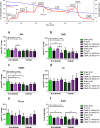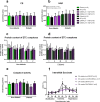Cardioprotective effect of succinate dehydrogenase inhibition in rat hearts and human myocardium with and without diabetes mellitus
- PMID: 32587298
- PMCID: PMC7316713
- DOI: 10.1038/s41598-020-67247-4
Cardioprotective effect of succinate dehydrogenase inhibition in rat hearts and human myocardium with and without diabetes mellitus
Abstract
Ischemia reperfusion (IR) injury may be attenuated through succinate dehydrogenase (SDH) inhibition by dimethyl malonate (DiMAL). Whether SDH inhibition yields protection in diabetic individuals and translates into human cardiac tissue remain unknown. In isolated perfused hearts from 24 weeks old male Zucker diabetic fatty (ZDF) and age matched non-diabetic control rats and atrial trabeculae from patients with and without diabetes, we compared infarct size, contractile force recovery and mitochondrial function. The cardioprotective effect of a 10 minutes DiMAL administration prior to global ischemia and ischemic preconditioning (IPC) was evaluated. In non-diabetic hearts exposed to IR, DiMAL 0.1 mM reduced infarct size compared to IR (55 ± 7% vs. 69 ± 6%, p < 0.05). Mitochondrial respiration was reduced by DiMAL 0.6 mM compared to sham and DiMAL 0.1 mM (p < 0.05). In diabetic hearts an increased concentration of DiMAL (0.6 mM) was required for protection compared to IR (64 ± 13% vs. 79 ± 8%, p < 0.05). Mitochondrial function remained unchanged. In trabeculae from humans without diabetes, IPC and DiMAL improved contractile force recovery compared to IR (43 ± 12% and 43 ± 13% vs. 23 ± 13%, p < 0.05) but in patients with diabetes only IPC provided protection compared to IR (51 ± 15% vs. 21 ± 8%, p < 0.05). Neither IPC nor DiMAL modulated mitochondrial respiration in patients. Cardioprotection by SDH inhibition is possible in human tissue, but depends on diabetes status. The narrow therapeutic range and discrepancy in respiration between experimental and human studies may limit clinical translation.
Conflict of interest statement
The authors declare no competing interests.
Figures








References
Publication types
MeSH terms
Substances
LinkOut - more resources
Full Text Sources
Medical

